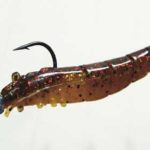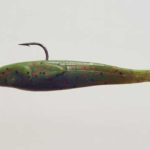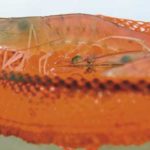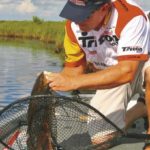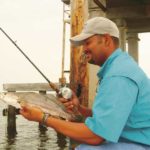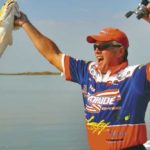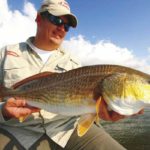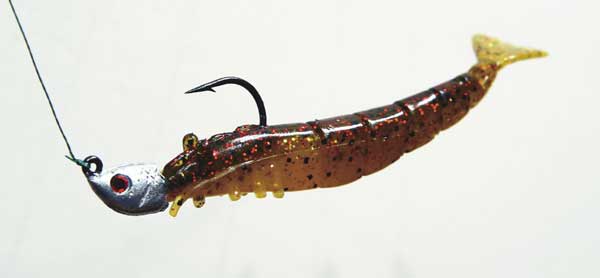
The new scent-impregnated baits are a hit with anglers because they’re an even bigger hit with redfish and speckled trout.
Do you remember how that wine glass shattered when Ella Fitzgerald hit the high note in a Memorex commercial several years ago? Then, to make you really think hard about their new audiocassette, the producers recorded her same note to the tape. Apparently the glass couldn’t tell if the note was live or not because it shattered again. Thus was born the long-standing line, “Is it live, or is it Memorex?”
That commercial may not have meant much to saltwater anglers way back then because they only had two choices. It was either live — sometimes dead — or it was a fake piece of petroleum-based plastic that had all the action of a blown big-rig tire coming through the water.
Since then, the saltwater bait marked has become inundated with a large assortment of plastics that push the engineering envelope. Some have tails that vibrate. Some have tails that wiggle. And some have tails that barely move at all.
It’s easy for us to tell that these baits aren’t live because we grabbed them from the pegs of a tackle store. For the fish, though, it’s getting harder and harder to tell if these new pieces of plastic are live or fake.
The distinction between live and fake baits was made even hazier when fishing companies started making spray-on scents that were supposed to not only mask any offensive human odor; they were also supposed to attract fish.
The thin line between live and fake baits became even more confusing when Berkley launched their popular line of soft baits called PowerBait. The reasoning behind Berkley’s initial foray into scent-impregnated soft plastics actually had as much to do with eliminating the added step of having to spray scent onto the bait.
However, there were some inherent disadvantages of having the scent locked up in a PVC plastic.
In an effort to create a bait that would release the scent into the water Keith Jones, Berkley director of research and development, knew they would have to come up with a plastic bait that acted more like biological tissue than plastic.
“Our Gulp! products are flavored baits whose liquid portion is water-based rather than petroleum,” he said. “Because it’s water-based, the bait is a lot more like a biological creature than a plastic bait in that the Gulp! releases scent into the water much faster, which is what we were initially trying to achieve.”
Since the Gulp! products hit the shelves, several companies have joined the technological race to be the best of the scent-impregnated natural baits. Robin Shiver, owner of Bass Assassin in Florida, recently introduced the Saltwater Assassin BLURP line of soft plastics that feature water-activated scent dispersal.
“Fishing with the BLURP baits is kind of like taking a chum bag and putting it out in the water,” Shiver said. “What we’re trying to do is attract saltwater fish that are accustomed to feeding by smell.”
Neither the Gulp! nor BLURP baits dissolve in the water like some may think. A big part of that misconception stems from the fact that Gulp! is biodegradable if lost to the environment. In this case, the bait will fall to the bottom where bacteria and certain funguses will begin to break it down into carbon dioxide and water.
Wanting to stay at the forefront of scent-impregnated bait technology, Berkley recently released its Gulp! Alive! product line, which many anglers have already seen on the shelves in their characteristic tubs.
“Gulp! Alive! is different from Gulp! in that the Alive! stuff is packaged submerged in their own juices, whereas Gulp! is packaged in bags with just a minimum of the juice in it,” said Jones.
“The Alive! offers several advantages to the Gulp!, one being that the baits are easily rehydrated by placing them back in the tub, and the other being that they hold their shape without kinking. When you take a Gulp! Alive! bait out of the tub, it is as soft and pliable as a soft bait can possible be. Technically, though, the Alive! is no more potent than the Gulp! technology.”
Being water-based, the Gulp! line of baits will eventually dehydrate if exposed to the air too long, and they will shrink to about a third of their actual size. As some anglers believe, this is a small price to pay for such a potent bait.
The BLURP plastics don’t have the perceived problem of drying up. Shiver says these baits are water-activated rather than water-based.
“They won’t dry up, but you also don’t want to expose them to water until you’re ready to fish,” he said. “The additive we add to the baits that triggers the scent release is activated when it hits the water. We didn’t just throw the BLURP together to get something on the market. We had biochemists working with us to develop this technology, and it took us a couple years to get it where we thought it needed to be.”
Another characteristic of the scent-impregnated baits is that they have a slimy feel, which is a byproduct of the scent being released.
“The slimy feel just turned out to be an extra advantage of the scent release,” Jones said. “It turned out to be a nice extra because it makes the baits feel much more life-like in a fish’s mouth.”
It’s great to hear from the developers of these products, but what are anglers on the water saying about them? In the case of redfish tournament anglers Capt. Charlie Thomason and Gregg Watts, they are saying great things.
“My brother Brian and I got some samples of the Gulp! three or four years ago,” said Watts, half of the formidable Watts brothers championship redfish team. “We knew when we first started fishing them that there was something different about them.”
As time progressed, Watts said they found out what the difference was, and it was utterly amazing. What they discovered is that the Gulp! catches everything in the water, and it does not discriminate.
“It actually evened the field in the redfish tournaments,” Watts said, “and the fact that other anglers had it hurt us pretty badly. Redfish are aggressive in Louisiana, but that’s not the case everywhere. And even in Louisiana, they aren’t aggressive all the time. Gulp! is a bait we can put on and use all the time because it catches them when they are aggressive and when they aren’t.”
Thomason says that fishing the scent-impregnated baits is similar to fishing dead bait on the bottom. Fish are attracted to the scent, and they come in to investigate. When they see what they perceive to be food, they can’t help but eat it.
“Think about the only reason somebody would fish cracked crab on the bottom,” Thomason said. “It’s all about the scent and bringing in a redfish to the smell. Also, think about when you go buy bait in the morning. Most people buy live and dead bait. When I throw the BLURP, I’m leaving a scent trail just like I would with live or dead bait.”
Both anglers have witnessed situations where these baits actually attract fish to an area. In the case of Watts, he loves throwing the Gulp! baits under the mangroves in Florida. Within five to 10 minutes, he can watch redfish migrate to the area to check out what’s leaving the scent.
Thomason has seen essentially the same reaction out of the fish. In one case he remembers well, he was able to watch fish respond to a BLURP bait in Florida.
“I was fishing the shrimp on a drop-shot rig one time so that it looked like suspended bait,” Thomason said. “While sitting there holding my line as perpendicular to the water as I could from my casting platform, I watched redfish swim toward the bait. As soon as one of them would catch the scent, it was automatic — they would eat it.”
Using Gulp! and BLURP is great in Florida where the redfish are heavily pressured and extremely shy, but what about it’s usefulness here in Louisiana where redfish attack anything from a shoestring to a bottle cap? Are they as effective here as they are elsewhere?
“The short answer is yes,” said Watts. “We’ve fished from the Gulf of Mexico to North Carolina, and we haven’t seen a situation yet where it hasn’t helped in some way. I’m a firm believer that the fish smell the scent as it disperses in the water, and they come in to investigate. Everybody who fishes wants to put fish in the boat, and it will help tournament and recreational anglers in Louisiana. Like the bag says, it outfishes live bait.”
Being from Louisiana, Thomason was a little more specific about the exact situations where the scent-impregnated baits would be beneficial. While he uses the BLURP all the time, he says the prime times for fishing them are the winter and the summer.
“Those are the two times our fish are most lethargic,” he explained. “When it’s cold, there’s not a lot of bait out there other than the mullet. The crabs go into the mud, and the fish aren’t going to chase a bait — especially the reds.
“Fish wind up keying on their smelling sense more so than their lateral line or their vision. You can throw the BLURP out and just leave it on bottom. When the fish pass by, the scent is going to force them to eat because it smells like something they really want.”
Thomason went on to explain that these baits work so well in the summer because of the remains of heavy feeding periods that fall to the bottom. Bits and pieces of shrimp, mullet and crab that weren’t eaten will sit on the bottom and get picked off by fish that go sniffing around.
Thinking about Louisiana again, Watts says that the extra attraction of scent is a tremendous help in dirty water — something with which all Louisiana anglers are familiar.
“Before we had scent, we used to do like the bass guys and add rattles to our baits in the dirty water just to get the reds to notice them. Now all we need is a little bit of current to get that smell washing around to make adding the rattles obsolete.”
Since it sounds like the scent-impregnated baits attract through scent dispersal while sitting still on the bottom, that brings up the question of if they are ideally suited for fast applications as well as they are for slower ones.
“As far as attracting fish chemically,” said Jones, “certainly slower presentations lend themselves better than faster ones. But you have to remember that there is a huge taste advantage that will cause fish that bite fast presentations out of reaction to hold on to the bait longer.”
Aside from the scent, there are some properties of these baits that make them much more natural-looking to the fish. According to Thomason, the BLURP baits are heavier than non-scented plastics, which allows him to cast farther without a jighead. The bait then falls slowly and steadily through the water down to the fish.
Watts uses the dense 4-inch Gulp Sinking Minnow on a 1/8-ounce jighead to make 40- and 50-yard casts into the wind. The extra weight of the bait coupled with the aerodynamic shape of the Sinking Minnow gives him an extra 5 feet per cast.
“That’s important in Florida where we want to catch these clear-water fish out as far as we can,” Watts added. “If we make a 55-yard cast, we want the fish to bite at 56 yards. That’s the key to catching those spooky Florida redfish.”
Gulp! and BLURP have become some of the more popular saltwater baits not only along coastal Louisiana but also around the world. Thomason and Watts say there’s no reason not to fish them because they put the odds in your favor 100 percent of the time. But, as the Gulp! tagline implies, do they really outfish live bait?
“We do a lot of field testing on our Gulp! and Gulp! Alive! products,” said Jones. “In many of those tests, our baits frequently matched, and in some cases beat, the live bait. What’s important to remember, though, is that no bait will consistently beat all other baits.
“Take an earthworm, for instance. It’s widely regarded as one of the best natural baits of all time. But even it won’t consistently outfish all other baits. The same can be said for Gulp! In some cases it will in fact outfish live bait, but it won’t do it all the time.”
In other words, it may not be Memorex, but as far as the fish are concerned, they can’t tell whether these baits are live or fake. And if the fish can’t tell, you can expect them to want to destroy your baits just like Ella Fitzgerald did that glass.
